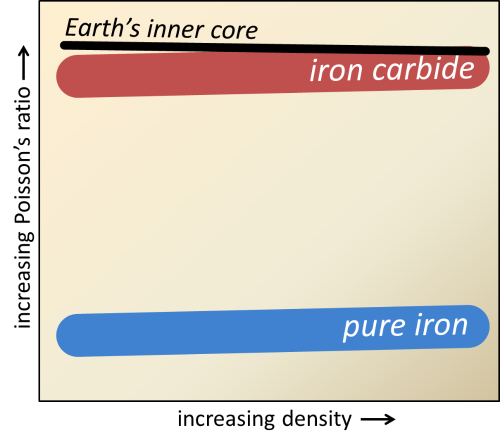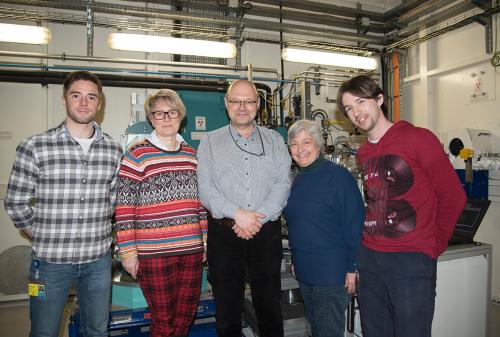- Home
- News
- General News
- What’s going on...
What’s going on at the centre of the Earth? Scientists think they have the answer
04-03-2015
Scientists looking for answers to questions such as ‘how did the Earth form 4.6 billion years ago?’ and ‘why do the current conditions on the Earth’s surface exist?’ have a new explanation for the way that the materials inside the Earth’s core are behaving. Examining conditions at the centre of the Earth is crucial not only for giving us a window back to Earth’s history but also to understanding its future and current environment. A team has used the European Synchrotron, the ESRF, to offer an explanation for a long unanswered question – what causes a core of mainly iron, to have unusual elastic properties? The results are published in Nature Geoscience.
Share
Researchers already know that iron makes up the bulk of Earth’s inner core. They use data from earthquakes to measure how long a seismic wave takes to reach the centre of Earth and through that, can calculate the properties of the materials that reside there. The theories are then tested by exposing those materials, through re-created laboratory conditions, to the extreme temperature and pressure at the centre of the Earth to see if they behave as predicted.
Less known, is what gives the Earth’s core the elastic properties it appears to have. Despite the bulk of the centre being iron, the core materials are displaying characteristics like rubber - a very different behaviour to that observed in pure solid iron. Proposals for candidate lighter elements that could be behind this elasticity include sulphur, carbon, hydrogen and oxygen which may either exist solely with iron or as a combination.
A new study involving Clemens Prescher and his PhD supervisors, Catherine McCammon and Leonid Dubrovinsky (all from the Bayerisches Geoinstitut, Universität Bayreuth), suggests that the material responsible for the rubber-like behavior could actually be iron carbide, proposing that a combination of carbon and iron could exist at Earth’s core.
Using ESRF’s ID09a high pressure and ID18 nuclear resonance beamlines the team has observed a new phase of the chemical compound.

The Poisson's ratio of iron carbide matches the value of the Earth's inner core much better than pure iron does. The iron carbide data comes from the present study while the data for pure iron were taken from the literature [Mao et al. 2001, Science 292, 914916; Murphy et al. 2013, J. Geophys. Res. B 118, 1999]. Credit: Catherine McCammon.
Placing samples of iron and carbon between two diamonds to create pressure 150 million times the pressure of the atmosphere and then heating them with a laser to 2000 degrees, they re-created the conditions near the centre of the Earth and examined the behaviour of the materials in that environment.
They found that the behaviour of the carbide compound under these conditions is consistent with the elastic properties in the Earth’s core measured by seismology and suggests that carbon could be present with iron. As elaborated by McCammon, “our new results support the idea that there is a carbon reservoir under our feet that is many hundred times larger than all of the carbon in the Earth’s surface regions put together“.

The team at ID18: From left to right : Valerio Cerentola (ESRF thesis student), Natalia Dubrovinskaia, Leonid Dubrovinsky, Catherine McCammon, Ilya Kupenko (Visiting scientist).
Credit: C.Argoud.
The result was made possible because of a combination of two techniques. Firstly single crystal diffraction on ESRF’s ID09a beamline which allows the structure of materials to be studied under world record pressures and secondly a development on ID18 that allows Mössbauer spectroscopy to be measured using synchrotron radiation. McCammon says, “the synchrotron Mössbauer source enables us to collect spectra in minutes instead of days so we can heat the high pressure samples with lasers and collect data under these extreme conditions”.
The result offers a new explanation for the processes at play at the centre of the Earth which are key to understanding more about how Earth formed, the reason for current conditions on the surface of the Earth – for example models of the carbon cycle are greatly improved with knowledge of activity at the core of the Earth - and to enable us to predict with more certainty, the future behaviour of our planet.
“After all”, concluded McCammon, “let’s not forget that the Earth’s magnetic field randomly flips once every few hundred thousand years or so, and it is the magnetosphere that shields us from the solar wind. It’s a very gradual effect that appears to happen over thousands of years but has a lot to do with the behaviour of the core and so the more we can understand about it, the better”.
For more details, see the paper entitled ‘High Poisson’s ratio of Earth’s inner core explained by carbon alloying’ in Nature Geoscience.
Top image: The Earth's inner core has unusual elastic properties with a Poisson's ratio close to the value for rubber. A cylinder with the same Poisson's ratio as the inner core would deform as shown in the figure when a force is applied in the direction of the arrows. Credit: Catherine McCammon.



